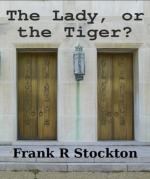
|
| Name: _________________________ | Period: ___________________ |
This test consists of 15 multiple choice questions and 5 short answer questions.
Multiple Choice Questions
1. What word from the narrative refers to the capacity of persons or things to be a compelling force on the behavior or opinions of others?
(a) Courage.
(b) Benediction.
(c) Apostate.
(d) Influence.
2. The narrator says in Part 2 of the story that the king's arena was built "for purposes far better adapted to widen and develop" what?
(a) "The logic and justice of the people."
(b) "The immigration of the people."
(c) "The talents of the people."
(d) "The mental energies of the people."
3. What do the hired mourners do if the criminal on trial is killed?
(a) They sing.
(b) They play stringed instruments.
(c) They dance.
(d) They wail.
4. How would you describe the setting of "The Lady, or the Tiger?"
(a) An ancient kingdom.
(b) A small country village.
(c) A contemporary town.
(d) A city filled with skyscrapers.
5. What artistic movement influenced Frank R. Stockton and other authors during his time period?
(a) The Dadaists.
(b) The Pre-Raphaelites.
(c) The Modernists.
(d) The Cubists.
6. What does the word "wend" mean in the narrative?
(a) To compose.
(b) To write.
(c) To sing.
(d) To go or leave.
7. How is the king's demeanor described when "some of his orbs got out of their orbits" in the beginning of the story?
(a) "Blander and more genial."
(b) "Flustered and anxious."
(c) "Controlling and dominant."
(d) "Obtuse and angry."
8. How are the iron bells described that ring if the criminal is killed in the arena?
(a) Doleful.
(b) Valiant.
(c) Merry.
(d) Incorrigible.
9. How are the vaults of the amphitheater described?
(a) "Placating."
(b) "Steel-walled."
(c) "Mysterious."
(d) "Cavernous."
10. What word from the narrative refers to a tissue inserted into another tissue?
(a) Devolved.
(b) Ingrafted.
(c) Progressed.
(d) Incurred.
11. What major theme of "The Lady, or the Tiger?" is established in the beginning of the story?
(a) Adultery.
(b) Revenge.
(c) Murder.
(d) Passion.
12. Where in the amphitheater does the king sit for the trials of criminals?
(a) On a throne on one side of the arena.
(b) In the arena itself.
(c) In the galleries.
(d) In a glass cage overlooking the arena.
13. Of the king, the narrator says in Part 2 that he "knew no tradition to which he owed more allegiance than" what?
(a) "Pleased his fancy."
(b) "The laws of God."
(c) "That of the guillotine."
(d) "Involved his family."
14. How is the king described in the beginning of the story?
(a) "Cultured and charismatic."
(b) "Semi-barbaric."
(c) "Logical but obtuse."
(d) "Intellectual and scientific."
15. Where was Frank R. Stockton from?
(a) Dublin, Ireland.
(b) Philadelphia, PA.
(c) New York, NY.
(d) London, England.
Short Answer Questions
1. What does the word "incorruptible" from the story mean?
2. What does the word "idealism" refer to in the narrative?
3. How are the king's "subjects refined and cultured," according to the narrator?
4. When was "The Lady, or the Tiger?" first published?
5. What literary movement is Frank R. Stockton associated with?
|
This section contains 493 words (approx. 2 pages at 300 words per page) |

|




